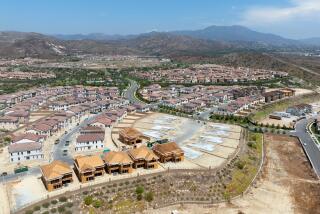Commentary : Functional ‘Urban Villages’ Can Make Metropolitan Areas Livable
- Share via
This year, a 10-year-old office building in Irvine was demolished and replaced by housing. At the nearby Orange County airport, another developer is planning to build condominiums on an empty site previously designated for offices.
How can this be happening? Don’t Southern Californians want to keep their homes and jobs far apart--and to enact zoning ordinances to ensure that never the twain shall meet?
And doesn’t conventional real estate wisdom dictate that the highest and best use for land is always commercial--thereby precluding the possibility of any housing being built near office buildings?
Not any longer. In almost every area of Southern California, the intermingling of our homes and jobs now makes good sense, whether you measure real estate values or human values. And this fact is transforming the structure of our metropolitan area as well as changing how and where we live and work.
Overall, these new social, economic and real estate trends can make our metropolitan area more functional and livable if we understand what is happening and plan accordingly.
In the historic industrial economy, Americans wanted to separate housing from jobs through zoning because factories blighted their neighborhoods with smoke, obnoxious smells and noisy rail sidings or truck deliveries. And this segregation of residences and workplace did not impose commuting hardships on most people because our cities were relatively small before World War II. Distances between home, job, shopping and entertainment were short.
But this rigid separation of land uses does not make sense any more, particularly for Orange County residents, many of whom have lengthy commutes between home and job.
The office buildings and high-tech installations of our post-industrial economy, which employs a large majority of Southern Californians, do not blight the surrounding area, as industrial factories did.
Indeed, the separation of homes, jobs, shops and entertainment within our vast amoeba-like metropolitan areas is now a problem because it creates excessively long commutes, infrastructure stress and clouds of automobile-induced air pollution. We have traded the soot-belching factory smokestack for the smog-producing automobile tailpipes.
But Southern Californians don’t need to be prisoners of obsolete zoning--or of their automobiles--any longer. In our post-industrial age, people are willing to live next to employment centers.
In Irvine, for example, $750,000- to $1-million houses are located next to an industrial-looking 25-year-old office park. In nearby Newport Beach, $1.5-million houses in a prominent country club stand across the street from high-rise office buildings and a regional shopping center. Orange County residents must look to developments like this as a model for their burgeoning office-retail-residential cores.
Indeed, some people are more concerned about the quality of their housing than its quantity, and they will accept less space and higher densities in return for easier access to jobs, shopping and cultural amenities. In Costa Mesa, a major high-density apartment complex next to the new Performing Arts Center rented far more rapidly than preliminary studies had anticipated.
In response to these new attitudes, the single-family house is being reinvented. Using high-density planning approaches like the Z-lot layout, developers can build seven or eight handsome single-family houses per acre, yet give each residence just as much interior space, privacy and status as the traditional suburban house. All the homeowner loses is the front lawn that has to be mowed every weekend.
As Southern Californians’ attitudes about the location and size of their homes has changed in recent years, so have regional real estate values. Residential uses now compete dollar-for-dollar with commercial uses. In Irvine, for instance, property for residences commands the same price as land for offices--$20 to $50 a square foot.
These changing attitudes about the location and size of desirable housing and the economic practicality of intermingling residences and workplaces could not have come at a better time. Our metropolitan area has evolved into a network of urban villages, which are work, residence, shopping and entertainment mini-downtowns amid the urban sprawl.
Orange County’s thriving Costa Mesa-Irvine-Newport Beach complex is Southern California’s most successful urban village because it has the nation’s busiest shopping center, the state’s third-largest concentration of office space, the Performing Arts Center and an increasing amount of housing--all in close proximity.
The emergence of these urban villages is not a happy accident. Many developers, planners and government officials have recognized the problems of our increasingly vast metropolitan areas and have begun to plan growth along the lines of the much more practical urban village pattern.
If more Southern Californians can update their obsolete zoning and encourage different uses to locate in close proximity, we can scale back our vast metropolitan area into smaller, more functional, more human-scaled urban villages.
The sooner that we do this, the sooner we can improve the quality of our lives by bringing our home, work, shopping and recreation closer together and reducing the time now lost commuting.
More to Read
Sign up for Essential California
The most important California stories and recommendations in your inbox every morning.
You may occasionally receive promotional content from the Los Angeles Times.






